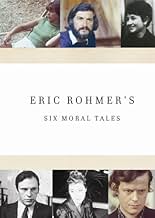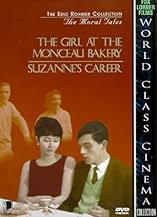NOTE IMDb
7,3/10
5,6 k
MA NOTE
Ajouter une intrigue dans votre langueA law student regularly visits a Paris bakery to flirt with a brunette employee.A law student regularly visits a Paris bakery to flirt with a brunette employee.A law student regularly visits a Paris bakery to flirt with a brunette employee.
Fred Junck
- Schmidt
- (non crédité)
Michel Mardore
- Client
- (non crédité)
Bertrand Tavernier
- Young Man
- (voix)
- (non crédité)
- …
Histoire
Le saviez-vous
- AnecdotesThis short is the first of Éric Rohmer's "Six Moral Tales".
- ConnexionsFollowed by La carrière de Suzanne (1963)
Commentaire à la une
The first of Eric Rohmer's six moral tales, The Girl at the Bakery Monceau is probably what newcomers to the unorthodox style of film-making Rohmer employs should first be exposed to. Not because they should be seen in order but more or less due to the fact that the film is under thirty minutes. As in all the tales the theme ( chauvinist male protagonist conflicted over two women) remains the same and in Monceau you are given a small dose of what will carry over into the full length explorations of men in self righteous struggle with reality and ideals.
A young law student on a nearly daily basis passes a young woman he is attracted to on the streets of Paris. Encouraged by his friend to pursue her he asks her out after literally bumping in to her. She agrees to set a date when they meet again but then disappears for days after. The young man begins to search for her by combing the area, sacrificing his meals to give him more time to do so. He substitutes pastry from a local bakery to cover his nourishment. Having no luck with finding Sylvie, he begins to pursue Jacqueline the bakery counter girl while he continues his search.
Rohmer's literary style can be quite trying and his protagonists obnoxiously condescending. His characters are neither heroic or noble. Rohmer's narrative style which depends heavily on interior monologue reveals some ugly truths that may not cause catastrophe but offer insightful points of view that makes the audience pause in reflection. We sometimes see ourselves in such reflections as well as friends and acquaintances.
Eugene O'Neil said "We live in illusion and die in reality." Nothing supplies illusion better than the darkened dream palace which allows us to storm a beach, race a car through city streets, go a round or two with Sugar Ray or get close to Sophia Loren and Ava Gardner. In all of his tales Rohmer narrows that gap, exposing a hum drum reality with a fickle illusion born of self deception. There is a subtle subversive reward to be found in all of the "Moral Tales" and with The Girl at the Bakery Monceau he is off to an excellent start.
A young law student on a nearly daily basis passes a young woman he is attracted to on the streets of Paris. Encouraged by his friend to pursue her he asks her out after literally bumping in to her. She agrees to set a date when they meet again but then disappears for days after. The young man begins to search for her by combing the area, sacrificing his meals to give him more time to do so. He substitutes pastry from a local bakery to cover his nourishment. Having no luck with finding Sylvie, he begins to pursue Jacqueline the bakery counter girl while he continues his search.
Rohmer's literary style can be quite trying and his protagonists obnoxiously condescending. His characters are neither heroic or noble. Rohmer's narrative style which depends heavily on interior monologue reveals some ugly truths that may not cause catastrophe but offer insightful points of view that makes the audience pause in reflection. We sometimes see ourselves in such reflections as well as friends and acquaintances.
Eugene O'Neil said "We live in illusion and die in reality." Nothing supplies illusion better than the darkened dream palace which allows us to storm a beach, race a car through city streets, go a round or two with Sugar Ray or get close to Sophia Loren and Ava Gardner. In all of his tales Rohmer narrows that gap, exposing a hum drum reality with a fickle illusion born of self deception. There is a subtle subversive reward to be found in all of the "Moral Tales" and with The Girl at the Bakery Monceau he is off to an excellent start.
Meilleurs choix
Connectez-vous pour évaluer et suivre la liste de favoris afin de recevoir des recommandations personnalisées
Détails
- Date de sortie
- Pays d’origine
- Langue
- Aussi connu sous le nom de
- Six contes moraux 1: La boulangère de Monceau
- Lieux de tournage
- Place de Lévis, Paris 17, Paris, France(street market)
- Sociétés de production
- Voir plus de crédits d'entreprise sur IMDbPro
- Durée23 minutes
- Couleur
- Mixage
- Rapport de forme
- 1.37 : 1
Contribuer à cette page
Suggérer une modification ou ajouter du contenu manquant

Lacune principale
By what name was La boulangère de Monceau (1963) officially released in India in English?
Répondre























